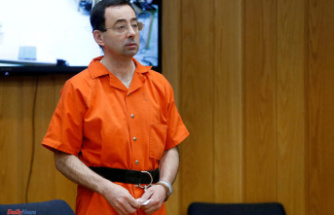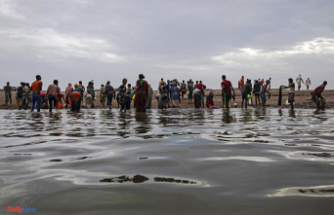They say that, from a certain age (50? 60?), If it does not hurt anything, it is that you are dead. It is a sentence to which, look at it from the perspective of the half full glass or from that of the empty half, we will have to face all and whose hardness will depend, once again, of our genetics, but above all of our habits of life.
"If you do not want problems tomorrow, do prevention today," says Dr. Antonio Ríos. He knows it better than anyone because, in addition to specialist in traumatology and orthopedic surgery, he treasures privileged joints that, freshly met 50 (yes, that critical age) continue to allow marathons and complete long-distance triathlies.
Entrances already in the forty and many others, patients who come to the Consultation of Dr. Ríos usually suffer from osteoarthritis, that is, "problems in the joints that carry weight or suffer impact, that is, on the hips and on their knees, which are The ones that have suffered most over the years and whose cartilage are more deteriorated by everyday activities as, simply, walk ".
And why does the osteohosis hurt? "Although the cartilage does not have nerve endings, it is suspected that the pain is the 'side effect' of the lesions of the neighboring structures, such as an inflammation of the joint capsule to the progressive deformation of the leg, microfractures of the bone underneath Cartilage and synovitis (inflammation of the articulation), etc. ».
Many times, he adds, "the clinical manifestations of osteoarthritis are nonspecific and could be given in any musculoskeletal disease such as clicks, deformity, rigidity or instability".
Other areas, on the other hand, ended up resinmed by overuse. "These ailments occur, above all, in people who have had a very active work life (in warehouses, workshops, construction, etc.), because repetitive movements are those that usually undermine the soft tissue (tendons)."
Although in our day-to-day we do not realize it, "a gesture as usual as climbing or lowering a heavy load repetitively, in such a way that our hands have to be over our head, can become the origin of A tendonitis on the shoulders ».
If we spend many hours performing an activity standing, without moving and head in the same position (packing, for example) will be "the cervical and their muscles who contract causing headaches, cervical muscle contractures and even dizziness with sweating and bad body". Or, if we use scissors or pincers to make movements of hand turning repeatedly, "the tennis elbow or epicondylitis will be a frequent pathology."
Converted into a spice of human gargoyles, a bad body posture in the chair sustained over the decades will also be invoice. "When looking at the computer or reading remain literally stooped, which causes a dorsal cifosis or drooping shoulder position. To compensate, the cervical spine tends to lift the chin so the cervical muscles contract for many hours. "
If, in addition, we have the computer on a side, the turn that we must perform repeatedly is harmful. "The lumbar column can also suffer if we are not correctly sitting with the back well supported by the backup." Otherwise, if this rotates on itself for, for example, removing an object from a drawer, we will cause "the same effect as a corkscrew, a repeated rotation movement that, in the long run, will damage the album and hernia will not take long In the act of appearance ».
But there is still more. When spending as long as sitting, "the hip and knees remain flexed 90º, with which the muscles of the anterior part of the hip is shortened as it is the psoas; The veins of the Corva on the knee are layered by that 90º position, becoming clear candidates to suffer varices since the circulation will cost more work to return from the legs to the heart ".
So that we are going to the idea, Dr. Ríos also warns us that "the back pain, what is called vulgarly Lumbalgia, will give us the tin with total security to all (especially males, before or after)."
Why? This is the explanation of him. "The lumbar spine is formed by five vertebrae. Between each of them, there is a disc that is a kind of pad whose function is to cushion the loads or impacts. However, over the years, this natural cushion, losing water and elasticity, sees reduced its effectiveness, producing stress on the joint ventures of the column and its premature aging ».
Therefore, if we persevere in our bad customs, such as carrying weight incorrectly, "the lumbar discs will deteriorate chronally and the tables of Lumbalgia will appear." And, if this situation is prolonged in time, you can even make your painful appearance the DISC hernia.
The next question would be, why all this Rosario de Dolores become more more in winter? «By various factors. First, the cold makes a vasoconstriction occur to counteract the loss of heat, which causes a lower blood supply to any articulation of our body, "explains this specialist.
With the drop in temperatures, in addition, "the viscosity of the fluids of our body is modified." Key in the lubrication and cushioning of the joints during movement, "the synovial fluid is one of the great damaged by those changes, becoming more dense and difficult to mobilize."
And there is still more, at this time of year, "the muscles also tend to contract, causing a tendon shortening that can affect performance and cause cramping or contractures."
So far, the bad news. The good ones? We have a certain margin of maneuver to mitigate the inevitable wear of aging: "Prevention is the key. If we compensate all the punishment that we submit to the body every day, then we will have a balance. " How? "Caring for postural habits when working or at home; Avoiding overweight, and above all, carrying out a preventive work of cervical strengthening, lumbar and, above all, of 'core', that central nucleus of our body located in the abdomen. "
Rivers affects the importance of "knitting a lumbar auto, made with the musculature that wraps the spine." In this way, "the discs will suffer fewer charges and, therefore, the possibility of suffering a hernia will be reduced." Also of "heating and stretching the muscles before and after our workday." It does not seem so complicated, right?
Date Of Update: 09 December 2021, 09:23











